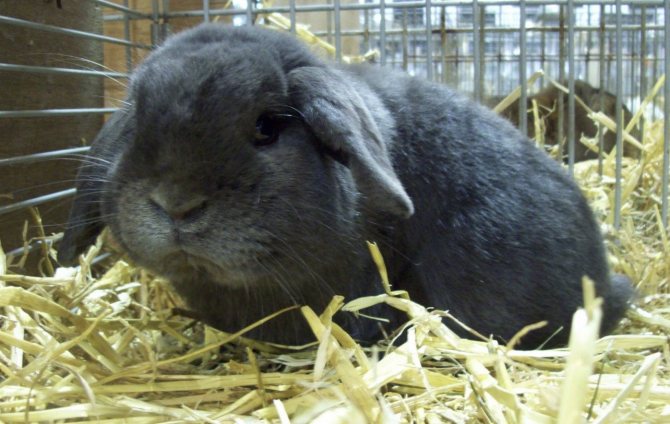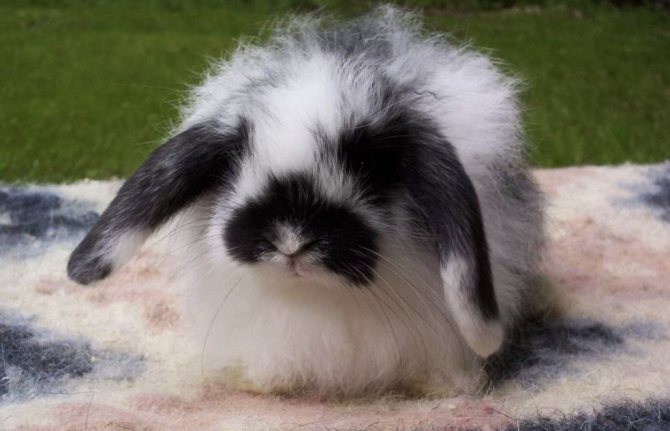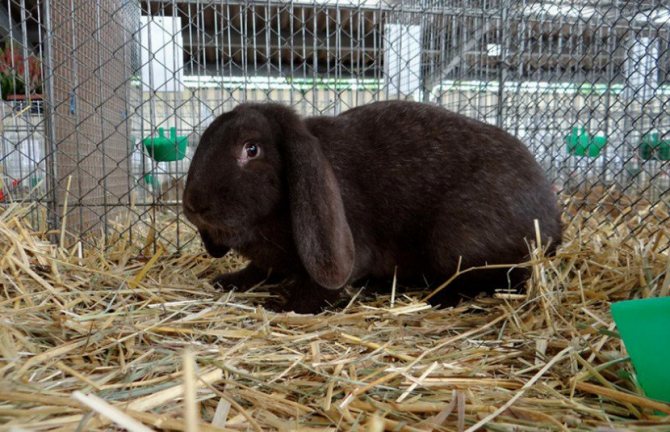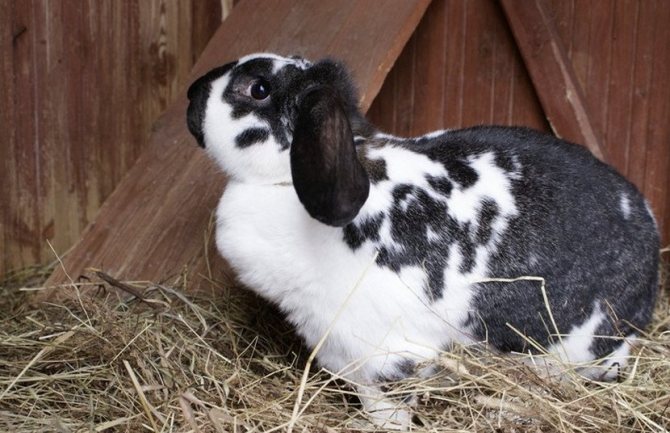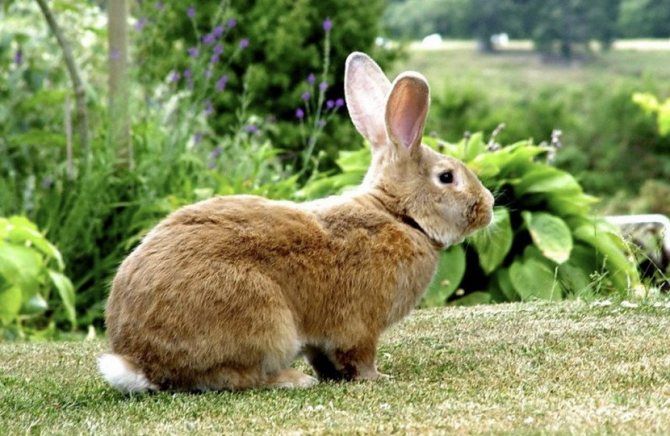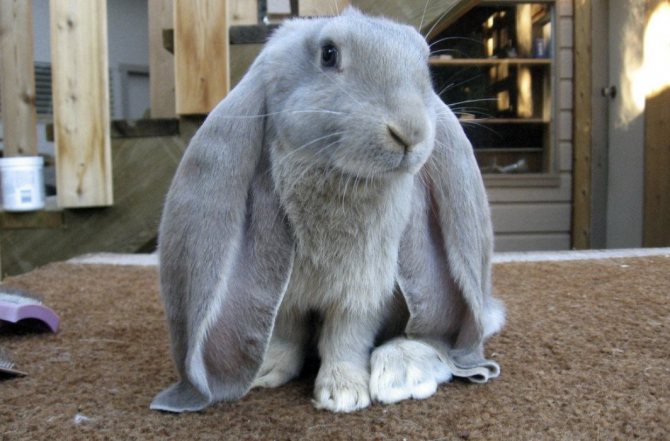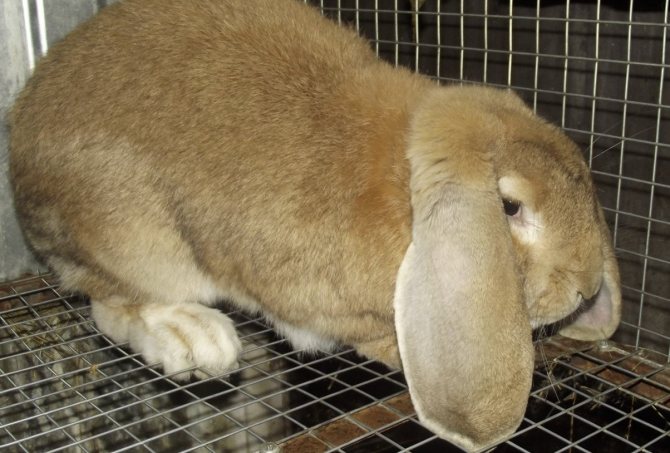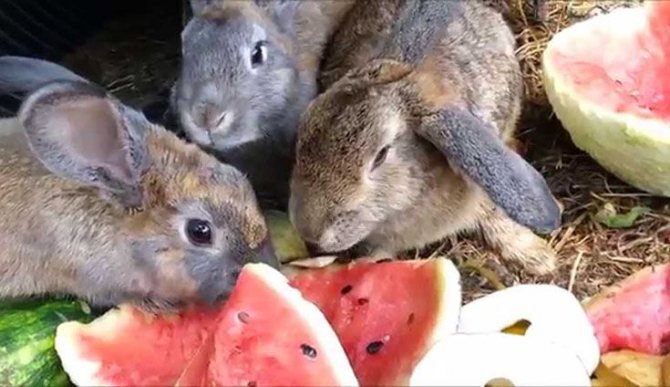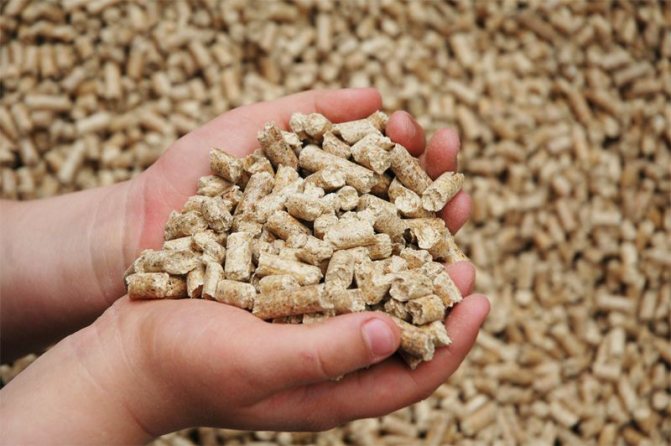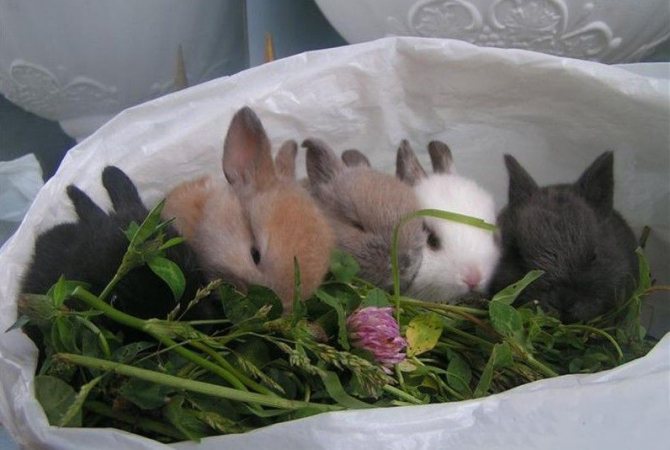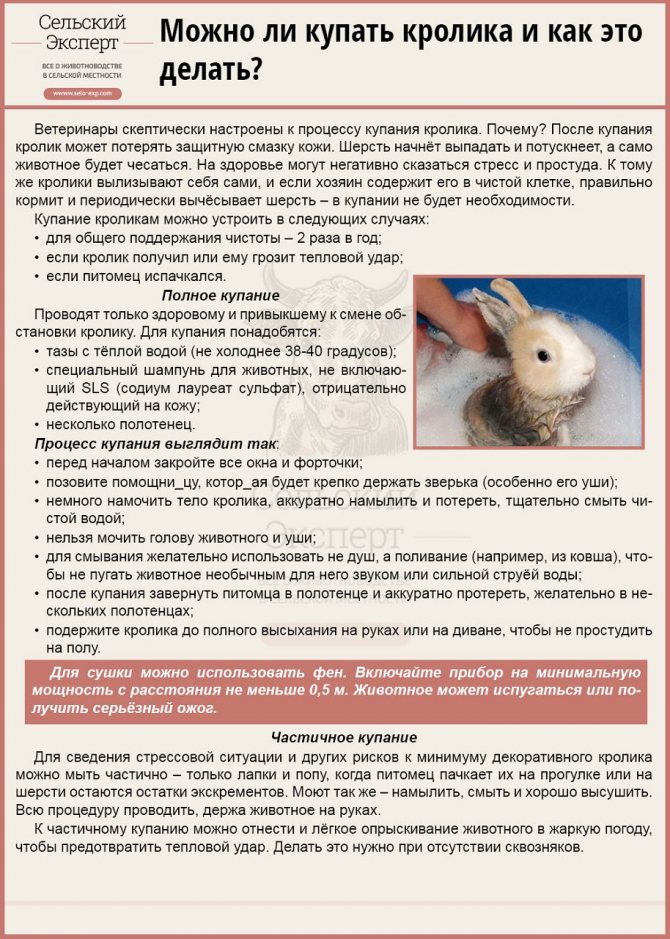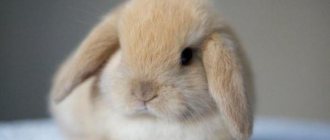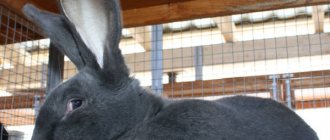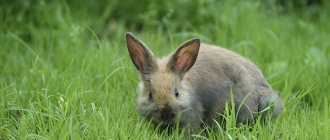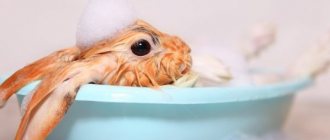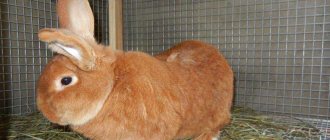Influence of the breed on the lifespan of rabbits
Experts are tirelessly working on a variety of decorative rabbit breeds. What do we have today?
First, the breeds of rabbits, depending on their weight, are small, medium, large.

Small decorative rabbits
Secondly, according to "fluffiness" - long-haired, short-haired and with wool of normal (medium) length.
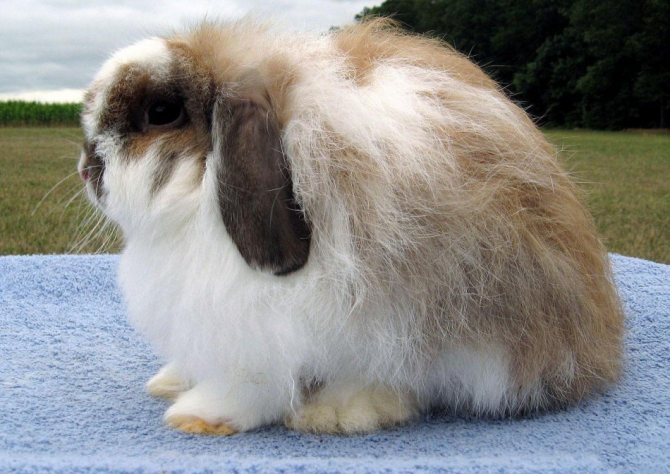

Long-haired decorative rabbit
In general, there are more than two hundred breeds, but let's dwell on the most common of them.
Colored short-haired dwarf rabbits are very similar in constitution to their distant ancestors, only the weight is much less (up to a maximum of one and a half kilograms). The color range of this breed is striking in its variety - about sixty color options. Interestingly, initially the colored dwarfs were light gray, then black, and only then did all the others appear.
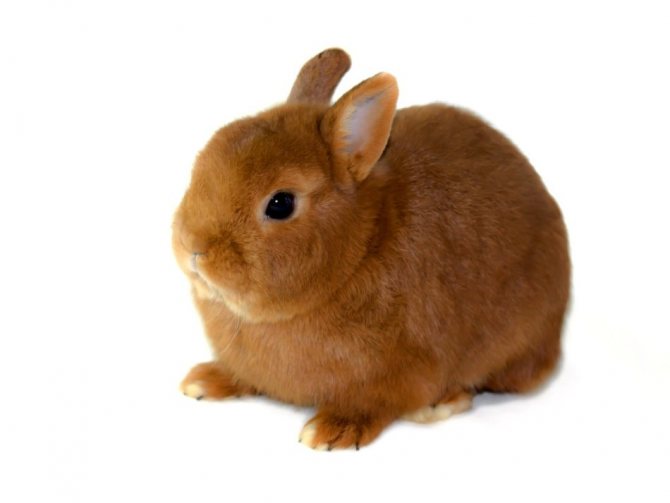

Colored shorthaired dwarf rabbit
Lop-eared rams are distinguished by drooping, short ears and a muzzle that looks like a miniature ram. The weight of such an animal reaches three kilograms, the coat is of medium length in various colors and shades. Surprisingly, these rabbits are very brave, quickly get used to people, very active, but without much fuss.


Lop-eared ram
Angora dwarf rabbits are lumps of wool jumping on the floor, since neither the eye nor the nose in this fluffiness is practically visible. The coat of these pets is very soft and pleasant to the touch.
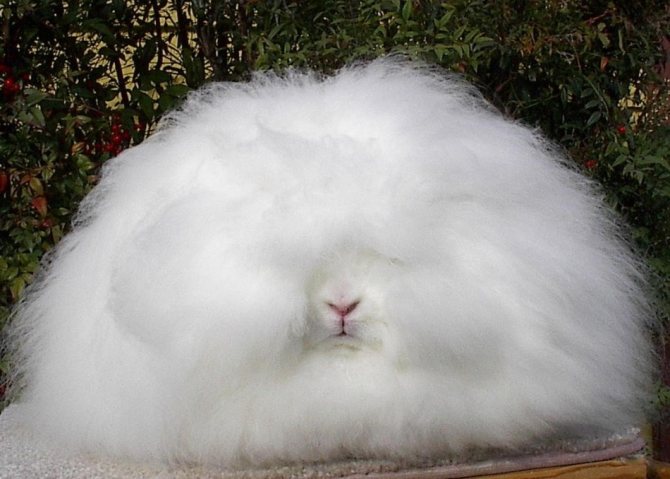

Angora rabbit
They lead a calm lifestyle, they do not like unnecessary, unjustified movements.
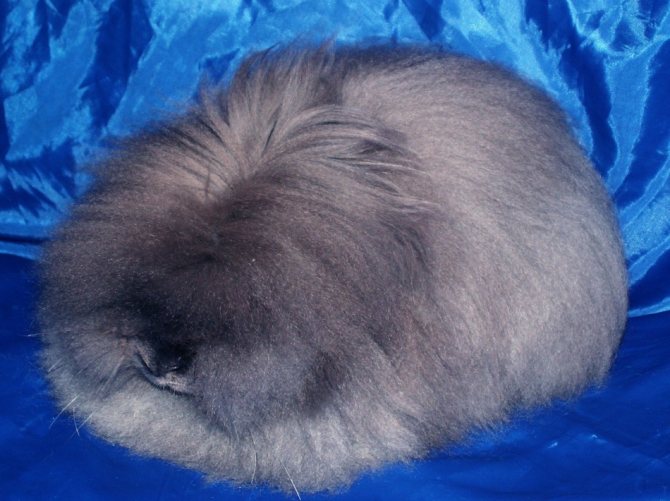

Angora pygmy rabbit
Hermelines or, as they are often called, Polish rabbits are very popular in England, Sweden, Norway and Denmark. In weight, they can reach one and a half kilograms. A distinctive feature is their snow-white coat, 2 mm long, and their muzzle resembles the Persian cats beloved by many. Erect ears are small and thin.
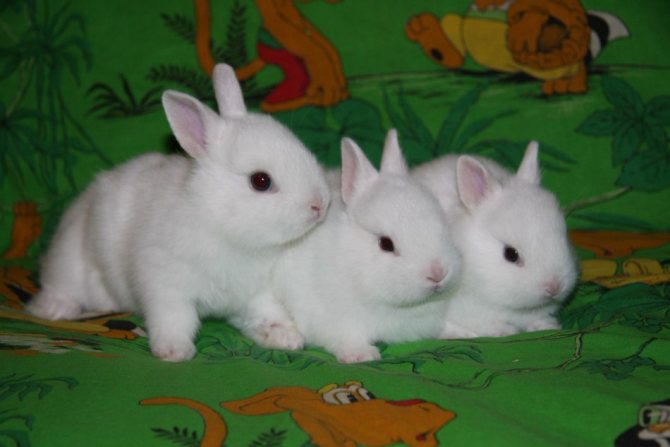

Hermeline
In nature, the rabbit lives less than their decorative counterparts. They are constantly fighting for survival, with a high probability they can become prey of a predator.
In order for rabbits to live longer at home, it is important not to forget to give them the appropriate vaccinations, to treat them in time in case of injuries and illnesses.
Some veterinarians believe that the breed does not affect the number of years. But all the same, the average indicators were derived for each breed of this pet.
Dwarf
It is impossible to give an exact figure in response to the question of how long these animals live. But there are average indicators. Rabbits of this breed at home can live for about 10-12 years.
Compared to rabbits, which naturally only have a lifespan of a year or two. A record was recorded when a dwarf decorative rabbit at home lived up to 18 years.
Lop-eared
The life span of lop-eared decorative rabbits is, on average, slightly longer than their counterparts with standing ears - 7-8 years. Lop-eared rabbits are less cowardly, so they cannot die from the stress of sudden fright. There is also an observation that the smaller the animal, the less it lives.
Wild specimens
If a wild rabbit was born and lived in natural conditions, and after that was taken home, then the likelihood that the pet will live a long life is extremely small. They usually live up to the age of two, but with proper care they can live for 5-10 years.
Long-lived rabbits
Dwarf rabbits are not long-livers in terms of average life expectancy. Today for pets to live 8 years is already a record. Most often, subject to all the rules for the care and feeding of animals, the animal lives no more than 6-7 years. But there are also exceptions. Several record holders even got into the Guinness Book of Records. However, the oldest furry was not honored to get there. In Scotland, according to some information, in ordinary apartment conditions there lived an eared eared, who died of old age only at the age of 24, but nothing is known about his breed.
Among the celebrities of the animal world, recorded by representatives of the Book of Records, the most famous are the dwarf rabbits Do from the USA (died at 17) and Floppy from England (died at 19). It is very difficult to reach this age without certain genetic characteristics of certain breeds.
How old do domestic rabbits live?
It is best to get a fluffy pet in specialized pet stores. They will tell in detail not only about the vaccines made, but also about proper care, and also recommend a certain breed depending on the wishes of the buyer.
Before you get such a pet, you should know how many years a decorative rabbit lives at home. Care and feeding mainly affect life expectancy. So if the animal is constantly exposed to stressful situations, it can get sick. Malnutrition or overeating also causes many health problems, which can significantly shorten his life span. The average life expectancy is 5 to 8 years.
How many years a decorative rabbit will live is also influenced by its breed. Lop-eared funny and playful animals. They live on average up to 8 years, a little longer than rabbits with erect ears. But with proper and careful care, they can live up to 13 years. Dwarf easily trainable, they can be walked on the street. The maximum weight of such a rabbit is 1.5 kg. On average, they live up to 5-7 years, but there are also centenarians who have lived up to 15 years.
Factors affecting life span:
- genetic inheritance, the healthier the previous generations were, the longer the current ones will live;
- infections, parasites and injuries;
- feed;
- conditions of maintenance and care;
- stress;
- castration.
The tubular bones of these animals are extremely fragile. Do not allow the rabbit to fall from a great height or be thrown, as this may break the vertebrae or the bone of the hind leg. There have been cases when animals injured themselves due to too large a jump made from unexpected fright.
Decorative rabbits have become very popular lately. These cute little animals are bought as a gift for children or just as their pet companions. Care and maintenance of animals is simple. Food for them is cheaper than meat for cats and dogs. After all, rabbits are herbivores, you can prepare hay for them yourself, and vegetables and grain cost a penny.
Decorative rabbits
Before deciding to buy a pet, read everything about decorative rabbits. It is important to learn how to care for them, how to feed them, what diseases they have. Then it is worth deciding whether you want to start a large or dwarf animal. After all, the size of the cage and the space that you should allocate for your pet depend on this.
You can keep a rabbit in a cage or aviary. The requirements for the cells in which they will live are as follows:
- It is advisable to choose the size 4 times larger than the size of the rabbit, the normal area is not less than 60 × 80 cm
- The pallet in the cage should only be plastic so that the baby does not damage his paws and claws, it should be washed before settling the rabbit
- The litter is made from sawdust or shavings, the rabbit will simply eat the straw
- It is necessary to prepare a special tray for the toilet, but it should be placed in the cage after the tenant has mastered it.
- Special manger for hay, feeders for grain and wet mash, drinker or bowl for water are placed in the cage.
- It is also necessary to equip a small house where the animal can hide.
- If desired, you can put a wheel or other toy in the cage
- The rabbit can grind its claws on its own if it has the ability to dig holes in the deep litter.
You can make your own rabbit aviary. It is necessary to build a fence of plywood or mesh, lay a wicker rug on the floor, covering it with sawdust on top. As in the cage, you need to put a manger for hay, bowls for feed and a drinker in the aviary. Be sure to come up with a small house for the rabbit, prepare a toilet tray for him.
We suggest that you familiarize yourself with: Indoor breeding maintenance home care
The cage or aviary should be placed in a shaded place, away from drafts or heating appliances. It is advisable that the rabbit lives in a bedroom, where people rarely go during the day. If this is not possible, settle the animal in the quietest corner of the house. During the day, he loves silence, the noise scares him greatly, the animal gets stressed. From excitement, the life expectancy of decorative rabbits is reduced.
Buying a rabbit
So, everything is ready for the reception of a new tenant in the house. Now you can start choosing and buying. It is best to purchase the animal at a trusted pet store or contact a nursery for decorative rabbits. This will give you a better chance of acquiring a healthy animal of the desired breed.
How to choose the right decorative rabbit? First you need to know that these animals come in regular and dwarf sizes. Mini animals will not take up much space in the apartment, they do not need a huge cage. The weight of babies is about 1 kg, and the weight of large decorative species is 3-4 kg. Plus, dwarf breeds look very cute. Large rabbits are also decorative, but they need a lot of space, feed, an aviary or a cage will take up almost half of the room.
Now it's worth deciding on the length of the coat. According to this principle, rabbits are divided into:
- Shorthaired
- Normohaired
- Long-haired.
Grooming for short to medium coats is very simple and does not need to be brushed. But long-haired ones require regular procedures, otherwise their fur will get tangled and look ugly. Rabbits also differ in the shape of their ears. Lop-eared rams are very popular now, they look cute, but they also require special care. Animals can have very different colors - white, black, white with black, red, gray, spotted, blue animals are very beautiful.
Breed selection and prices
The oldest decorative breed is considered to be the white Polish decorative rabbit Garmelin, who bred it is unknown. The most popular and beautiful varieties:
- Hermeline
- Dutch color minor
- Lop-eared dwarf ram
- Angora
- Vienna blue dwarfs
- Lionheads
- Foxes
- Japanese
- Dwarf Rex
How much does a decorative rabbit cost? This question often worries novice owners. The cost of decorative rabbits depends on the breed, its purity and the place of purchase of the animals. The price for dwarf pets starts at 1000 rubles per individual. You can find it cheaper, but the quality and health of such animals is questionable.


Before buying, be sure to read how to distinguish breeds, see how the rabbits look when they grow up, carefully study the description and characteristics, colors, etc.It is best to buy an adult rabbit, the ideal age is six months. Maintenance, feeding and caring for it are simpler.
How to care for decorative rabbits? What conditions does he need? To make your pet feel normal, you should adhere to a few rules:
- Decorative rabbits tolerate cold well, but do not like heat. The optimum temperature for them is 18-20 degrees. If it is very hot in summer, place a damp towel on top of the cage or place an ice bottle inside it. You can wipe the rabbit's ears with cool water, since heat exchange occurs through the veins of these organs.
- Rabbits are nocturnal animals, during the day they sleep and become active in the evening, closer to 18 o'clock. Therefore, you should not bother them in the morning and at lunchtime, it is advisable to remove unnecessary sounds and fuss from the house at this time, or put the cage in the far corner.
- Fluffy animals are very clean, they go to the toilet in one place. You need to track where the bunny crap and put a tray there. The cage is washed 2-3 times a week to avoid the appearance of an unpleasant odor.
- In order for the rabbits to feel good about themselves in the apartment, they need to be walked daily. For this, the baby is released from the cage for 1-2 hours, after removing everything that can be eaten from the floor, as well as dangerous objects so that the rabbit does not injure itself. Walking outside is also permissible, but only in dry, warm weather and on a harness.
The place should not be in direct sunlight or in a draft. The most acceptable temperature is 18-20˚С.
Be sure to clean the tray every day.
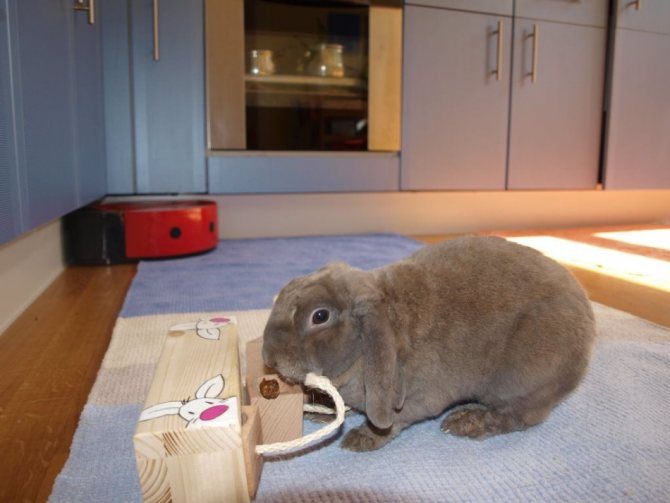

Decorative rabbit at home
The cage for such rabbits should be about 0.5 mx0.7 m, if possible with a house (for the pet's confidence in its safety), bowls for food and drink should be fixed.
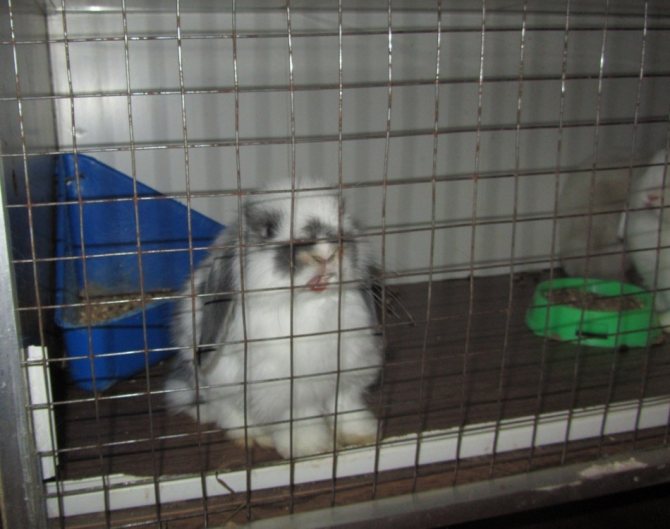

Keeping a decorative fold rabbit in a cage
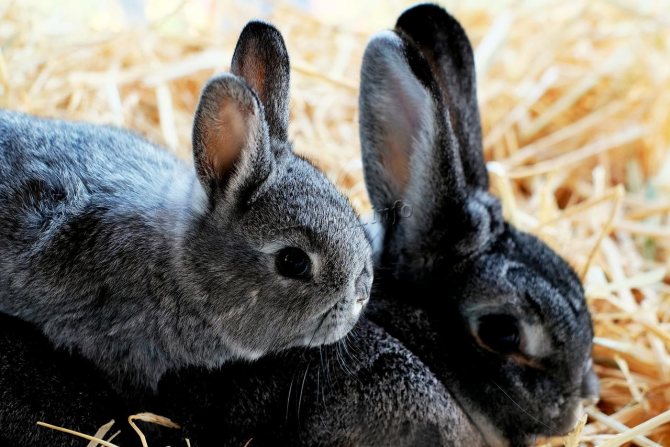

Domestic rabbits photo
The domestic rabbit lives from 7 to 15 years. The life span of a rabbit at home depends not only on its species, breed, but also on a number of other factors. The higher the quality of life, the longer the rabbit will live - this is a proven fact. Below are the factors that directly affect the life span of lop-eared pets.
- Food. If the rabbit is malnourished or eats bad, low-quality food on a regular basis, then this does not bode well for his body. If it does not get poisoned, then in any case problems with the gastrointestinal tract may appear and, as a result, the life span will be reduced.
- Living conditions should always be good. Cleanliness, space, convenience, comfort, silence - this is what any rabbit should have at its disposal.
Important!
If the rabbit begins to behave strangely or looks sickly, you need to urgently go to the veterinarian. In rabbits, diseases develop quickly, so you can't delay it!
- Physical activity is important for rabbits. Even breeds bred for meat should be able to move freely. This is reflected in their appearance and lifespan.
- Castration makes the animals calmer and this, oddly enough, increases the life of the pet.
- In the case of rabbits, like any other living creature, heredity can be key in terms of life span. The fact is that a fluffy can inherit a serious illness or a mild illness from his parents, physical abnormalities that will reduce the quality of life. That is why buying a rabbit without knowing its parents is a bad idea.
Check out these articles as well
- Galvanized beds
- Cherry grafting on cherries
- What can you feed ducks?
- Pear variety Marble
The more difficult the life of an animal, the more dangerous it is, the less the animal will live. At the same time, a cared-for eared, who receives wholesome, nutritious food and lives in clean conditions, can live for more than 10 years and have excellent health.
Interesting!
Rabbits are able to remember their name and, moreover, they can learn to go to the toilet in the litter box, like cats.
We recommend reading our other articles
- Alligator cucumber variety
- Honey extractor - what is it, types
- Pruning roses
- Description and characteristics of the incubator Cinderella


Photo of a decorative rabbit
Wild specimens
Which breeds live longer
According to the results of many years of observations and reviews of the owners of the eared rams, the Lop-eared ram lives the longest.
This breed has a longer life span even without proper care. In the absence of serious genetic abnormalities, as well as acquired diseases, an individual lives up to 9 years. The Rex breed is considered a little less tenacious. Each of its representatives lives up to 5-7 years. Colored Dutch rabbits have the same lifespan.
How long a rabbit provided for everyone lives on. What can a person count on, who makes every effort to prolong the existence of his pet? According to experts, pets can easily be kept for another 12-36 months by the average life. Often, a good attitude of the owner becomes the main criterion for the longevity of these pets. If an individual dies by the age of 13 or 14, all these years lived are the merit of the owner.
A wild animal lives much less than a pet. And this is due to several factors. According to scientists, in 90% of cases, small rabbits live longer than their larger counterparts. In addition, how long a wild animal will live depends on natural factors, because lagomorphs prefer to spend most of their lives in burrows, which are occasionally flooded with groundwater. In addition to precipitation, there is a high risk of being eaten by a more formidable animal, therefore, the life expectancy of wild rabbits is measured in 2-4 years.
Names for bunnies girls and boys
The pet's nickname should be short and sonorous, then he will quickly learn it.
Many owners choose a nickname based on the obvious distinctive features of the rabbit: color, habits, character traits:
- An albino pet, if he is a boy, can be called White, Snowball, White, if a girl - Blonda, Snowball, Anzhi, Belian
- For gray rabbits, the names Gray, Smoke, Brass - for boys, Mini, Smoke - for girls are suitable
- A restless kid can be called Shustrik, Dashing, if a boy, if a girl - Minx, Shursha, Shusha
Some rabbit owners name their pets after their favorite characters from feature films and cartoons:
- Elsa, Feona, Jasmine, Gloria, Bella, Hera for females
- Nemo, Marty, Funtik, Kuzya, Simka for males.
There are masters who humanize their fluffy and call boys by male names - Vanka, Max, Zhorik, and female girls - Lana, Nora, Shura.


The decorative rabbit will quickly get used to its name and learn to resort at the first call
Life expectancy depends on breed, health, grooming and nutrition. But there are very specific statistics: large rabbits live 4-5 years, dwarf ones live up to 8 years, lop-eared ones live longer than pets with erect ears. The second half also prolongs the rabbit eyelid.
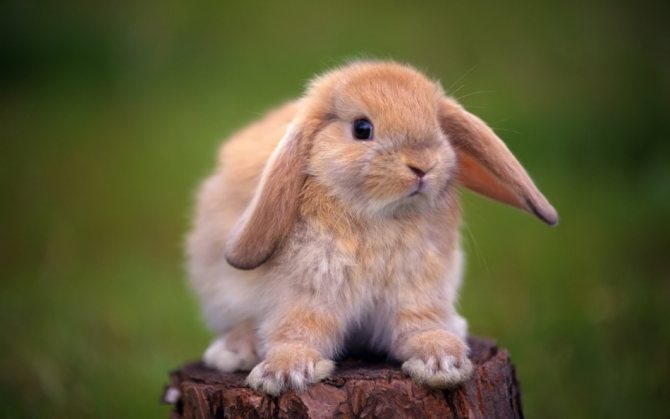

Lop-eared decorative rabbits live longer than straight ones
How long do decorative fold rabbits live?
Lop-eared rabbits have a playful character, they are active and cute. They are loved by adults and children, because these animals easily find a common language with people and are able to show and accept tenderness. A characteristic feature of these animals is a compact knocked-down body, the back of which is widened, a flattened pretty face and hanging ears.
According to statistics, the average lifespan of a rabbit with drooping ears is several years longer than that of pets with straight, erect ears. At home, with good care, they can live for about 8 years.This is the average. Some rabbits live to be 12-13 years old.
How to choose a cage, house, toys for a decorative rabbit?
The cage should not be very large: for small and medium breeds - up to 1 m2, for large - up to 140 cm2. There must be a toilet, drinkers, feeders in the cage.
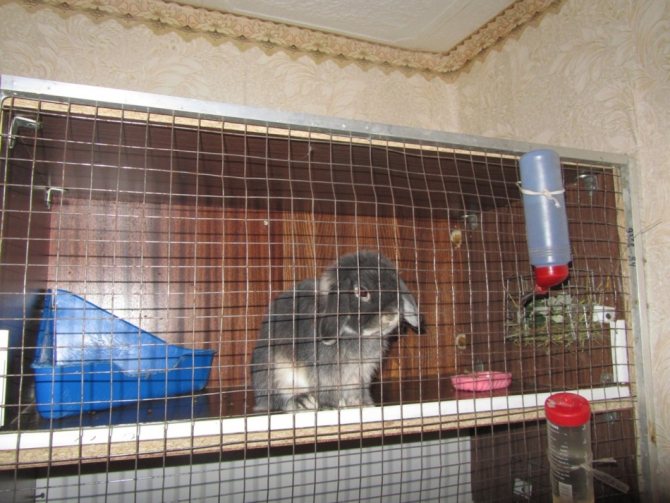

Equipped cage for a decorative rabbit
For dwarf rabbits and pregnant rabbits, a house should be installed in the cage. The cage should be in a calm, bright place.
You can buy a rabbit cage at a pet store or build a house for your pet yourself.
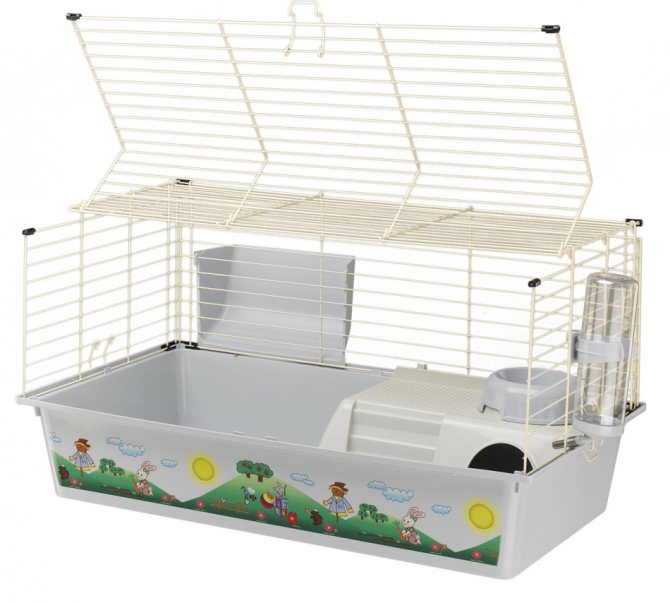

A rabbit cage can be purchased at a pet store
To prevent the rabbit from spoiling anything, he needs to buy toys and play with him. A ball with a rattle, a linen rag, a box with moves are ideal for entertaining your pet.


Decorative rabbits love to play
Dwarf rabbits lifespan
Rabbits are kind, affectionate creatures. Keeping them at home brings joy to all family members. In this regard, the question arises: how long do dwarf rabbits live?
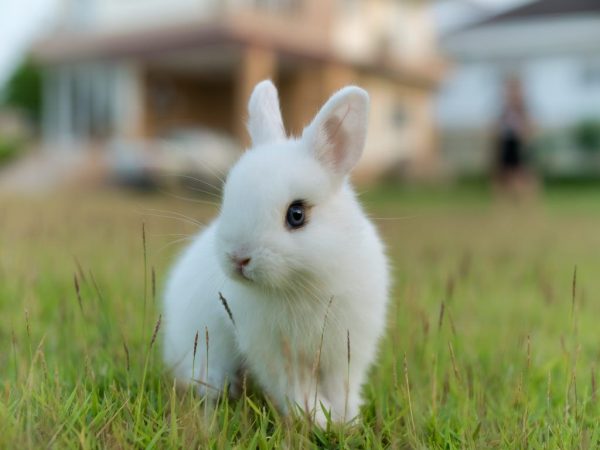

How long do dwarf rabbits live?
If you want to find yourself a reliable friend for a long time in the form of a pet, you should study the characteristics of individual breeds of these animals well.
How to feed a decorative rabbit: food?
Since food in these rodents is digested quickly, they must eat all day.
The menu should contain solid feed, vegetables, fruits, berries, herbs, tree branches (for grinding teeth), hay, vitamins, mineral and animal supplements.
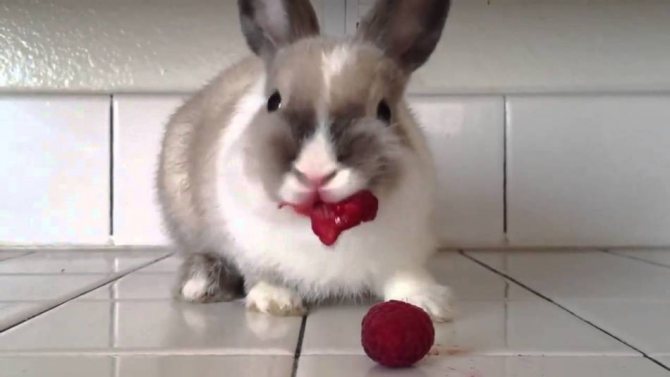

The decorative rabbit menu should be varied.
Conditions that can affect the lifespan of a decorative rabbit.
When buying a dwarf rabbit, you should familiarize yourself with the rules of caring for it and the features of its maintenance. This will help create optimal care for your pet and will significantly affect the quality and duration of its life.
Factors affecting how long decorative rabbits live:
- Active lifestyle... A rabbit that spends all its time in a cage will not be vigorous and healthy for long. Even if people living in the apartment started it, you need to let your pet frolic for at least a couple of hours.
- Cage dimensions... Keeping a bunny in a cramped environment is not the best option. Recommended sizes are not less than 70x70 cm. The rabbit should be able to stretch out to its full height inside its dwelling. The inside of the cage should always be clean, you need to provide the pet with constant access to food and drink.
- Optimal climatic conditions... Animals are very sensitive to high temperatures and overheating. Direct sunlight is extremely contraindicated for them. If there is a desire to increase the years of life of a beloved pet, you do not need to keep it in rooms where the air temperature is higher than + 20- + 22 degrees. FROM.
- Food... The rabbit needs a variety of food. Fresh hay is his main delicacy. You can sprinkle flour on the hay for more nutrition. You also need fresh grass, as well as tree branches and their bark. Of vegetables, cabbage, potatoes, carrots are recommended as top dressing. The use of mineral supplements and vitamins is allowed.
Compliance with all of the above requirements will allow the decorative rabbit to live for several years more than nature allotted for it.


Do decorative rabbits get bathed?
You can bathe rabbits in case of emergency. This must be done very carefully so that water does not get on the head and ears. Use only special detergents or baby soap.


Decorative rabbits are bathed if necessary
Factors affecting rabbit longevity
Zoologists studying the lifespan of rabbits drew attention to the fact that the longevity of an animal is directly depends on the conditions of its detention... At home, with proper nutrition and good care, decorative animals can live up to 10 years.
Wild hare-like animals live only about three years. Their high mortality rate is due to unfavorable living conditions, predators and various diseases.
Life span decorative rabbits at home depends on the following factors:
- Lifestyle. Active animals must constantly move, for which they need to be released to run several times a day. The duration of the walk should be at least one hour.
- Care, maintenance and balanced feeding. Particular attention should be paid to pet nutrition, as they have a very delicate gastrointestinal tract. Dwarf rabbits are especially susceptible to various diseases of the gastrointestinal tract.
- Heredity. Many diseases are transmitted genetically, so when buying a pet, you need to find out about the diseases of its parents.
- Colds and various injuries. When keeping decorative rabbits, you should protect them from drafts, monitor their movement and play very carefully so as not to injure the animal.
- Castration. Experts say that castrated animals live longer than breeding animals. Most of all this concerns females, whose body is very worn out due to childbirth and feeding of rabbits.
Signs of rabbit aging include decrease in its activity, thinning of the coat, cloudy eyes and sagging belly. If, with all these signs, the animal no longer bothers, then it means that the pet has crossed the aging phase.
How to toilet train ornamental rabbits?
The principle is the same as with cats and small dogs. You need to buy a tray, pour sawdust there and as soon as a puddle appeared on the floor, scold the baby and take it to the tray, without ceasing to blame him. Then moisten the sawdust with urine so that he can smell it.
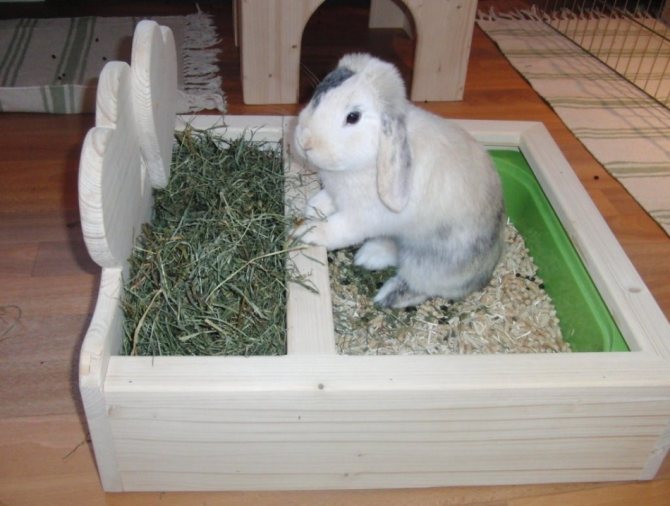

It will be possible to train a decorative rabbit to the toilet quickly enough
Castration
Both females and males are castrated. The operated specimens live longer. In non-castrated males, cancer and tumors of the genitals are more common, and life expectancy is reduced.
Rabbits sterilized after the birth of offspring are protected from new pregnancies and childbirth, which wear out the body and undermine health by hormonal shocks. If you do not mate a rabbit, then without sterilization, such specimens develop oncological diseases. And after the operation, the animals will live up to 8-12 years.
Do decorative rabbits have fleas?
Rabbits in this regard are no exception and it is dangerous that they are transmitted to other animals and humans.
But it is better not to bring it up to this, but to use a collar or preventive drops 2-3 times a year.
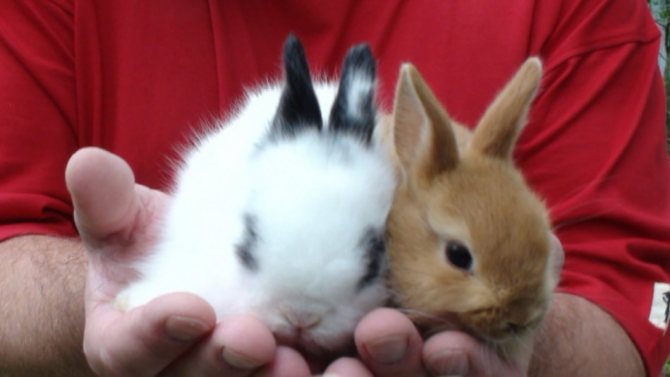

Fleas from decorative rabbits can be transmitted to other animals
Popular breeds of decorative rabbits and how long they live.
The most popular breeds are dwarf varieties and lop-eared rabbits.
Lop-eared ram. Unpretentious breed. The name was given for the fact that in sexually mature individuals the ears do not stand upright, but hang down. Sometimes only one ear can hang down. Rabbits of this species are playful and intelligent, quickly becoming everyone's favorites.
California rabbits. They have a white body color, black ears, paws and nose. Animals of this breed have a calm temperament and curiosity. They practically do not create problems for their owners.
Angora dwarf rabbits. The long fluffy coat of this species is affectionate not only in babies, but also in adults.
Dwarf Rex Rabbit. They can have a different color - from white to red and even black. A distinctive feature - "plush" fur, which is not possessed by any other representative of the family of these animals.
Whatever breed the domestic rabbit is, their lifespan is about the same: with perfect care, they will delight the owners for 7-8 years.Individuals that live up to 10 years are considered phenomena.


The decorative rabbit has red urine
The owners should not panic, as the color range of rabbit urine is very diverse: from light yellow to brown.
This phenomenon is explained by the presence of plant pigments in the urine and does not harm the pet's health.


A decorative rabbit may have red urine
What affects the lifespan?
In the wild, rabbits rarely step over the age threshold of 3 years, while pets are more fortunate: they do not suffer from predators, they eat well, and are less stressed. The life expectancy of pets is influenced by various factors:
Rabbit being examined by a veterinarian
- Infections. Decorative rabbits have a very weak immune system. They can die in a matter of days from infectious diseases: myxomatosis, coccidiosis, VGBK, rhinitis and stomatitis.
- Traumatic factor. If the rabbit falls from a height, it can break the spine or damage internal organs. It is important to keep your pet safe in order to avoid ridiculous death at an early age.
- Genetics. Like human health, the rabbit is affected by heredity. Healthy parents give birth to children with strong immunity. The same rule applies to animals.
- Food. The diet of the eared animal must be properly balanced. Lack of nutrients, vitamins and microelements in the body always adversely affects health: vitamin deficiencies and various diseases develop, immunity decreases.
- Hygiene. If the rabbit is kept in unsanitary conditions, cleaning in the cage and disinfection is neglected, the likelihood of developing diseases is high.
- Stress. Decorative rabbits have a sensitive nervous system. Frightened, they may die from a ruptured heart. It is important to provide the animals with peace, to avoid situations that could cause fear or shock. Loud, harsh sounds, change of scenery, medical procedures, car trips - all this little animals are afraid of.
- Castration and sterilization. A rabbit will live several years longer if neutered at a young age. The same goes for bunnies. Frequent bearing of offspring and feeding of cubs takes away the strength of the female, her body wears out faster. If you do not plan to purchase a pair for a decorative rabbit, you should think about castration.
Diseases of decorative rabbits
It makes no sense to describe all the diseases, since there are a lot of them, so we will characterize the main ones:
- viral hemorrhagic disease (VHD), which affects rabbits from two months to six years, cannot be cured. The animal's temperature rises, the lips turn blue, breathing slows down, blood flows from the mouth and nose, and diarrhea begins. There is no chance of saving the rabbit, since the disease is practically unexplored, and there is currently no cure. Prevention is important - vaccination
- gastrointestinal stasis can kill a pet, as pathology occurs in the intestines. The reason may be a lack of hay in the diet or accidentally swallowed wool. The rabbit becomes lethargic, knocks its teeth, does not eat, does not empty itself. With such a vivid symptomatology, you should immediately contact the veterinarian, who will prescribe an enema, massage, and appropriate medications. If this does not help, you can operate the pet, but it is difficult for him to recover and usually the animal dies
- urinary dermatitis is characterized by hair loss in the groin and on the hind legs, inflammation and redness of the skin. Steroid medications are prescribed for treatment
- coccidiosis - infection with parasites transmitted through feces. This disease is characterized by weakness, bloating, and refusal to eat. You need to treat immediately so that there is no infection of other organs.
- myxomatosis, transmitted through fleas and lice, like VGZ, is fatal and cannot be treated.The animal stops eating, the eyelids swell, very painful blisters appear, and a week later death occurs
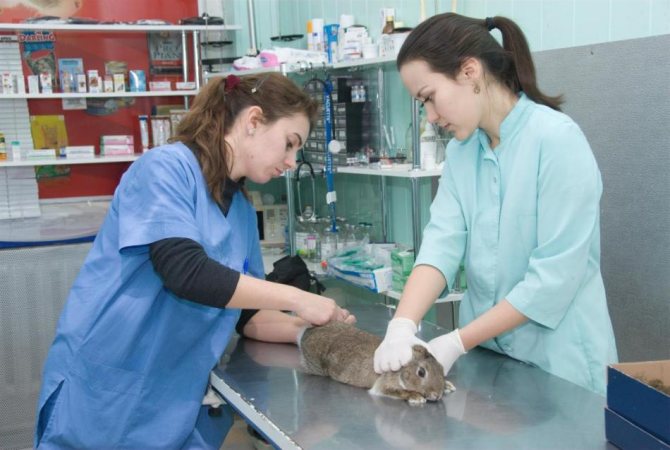

If signs of illness appear, the decorative rabbit should be shown to the veterinarian
Life expectancy factors
Dwarf decorative rabbits require more careful care than regular breeds. The lifespan of individuals is influenced by several main reasons, each of which can become critical.
Heredity
When choosing a pet, you should pay attention to the life span and health of the parents - they must be excellent.
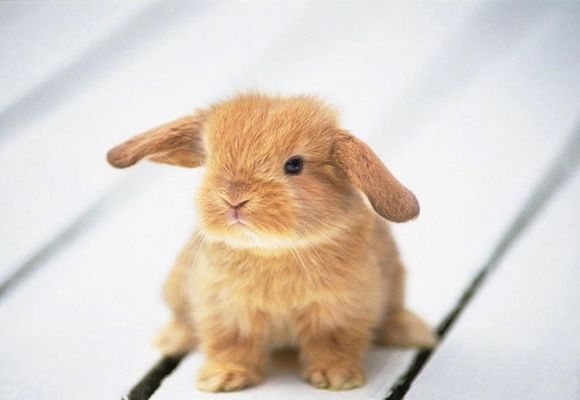

If there is information about the hereditary characteristics of the animal, the weak points of the body, you can pay more attention to prevention and prevent the disease.
Care
Rabbits are clean animals that require comfortable maintenance. They need to be protected from trauma and stress - attacks of large animals, falls from a height (when carried on their hands), from being squeezed by children, sudden fright.
The crawl cage should be comfortable, provide free movement of the animal inside. It should contain devices and items to ensure physical activity: ladders, labyrinths, pipes, balls, pine cones.
The cage should be installed in a calm place, protected from drafts and bright light.... It should not be placed near heating sources (stoves, radiators, convectors) - rabbits do not tolerate high temperatures well.
For the same reasons, it cannot be kept in the sun. Rabbits are very sensitive to stale, stuffy air in the room, excessive humidity and ammonia odors from the litter.
You should protect your pet from loud sounds, which he is afraid of - do not install the cage next to the TV or music center.
Caring for dwarf rabbits includes regular cleaning of the cage, cleaning the toilet. A neat animal often refuses to enter a dirty litter box, and chooses a toilet in another corner of the cage.
The animal cannot be bathed and washed - this procedure can be performed only if necessary. The water for washing should be warm, a wet rabbit should be protected from drafts, kept wrapped in a cloth until dry.
Walking
High activity is inherent in the rabbit by nature. Ignoring this feature and long-term maintenance of the animal in a cage together with abundant feeding leads to obesity, poor functioning of the digestive system and liver.
For a pet's health, it is important to walk outside the cage for at least 60-90 minutes a day, it is best if this happens outdoors.
It is advisable that there are no dogs and other large animals in the walking area - the rabbit can get scared and get sick.
On a walk, the pet should not be left alone in order to avoid injury and hassles with other animals.
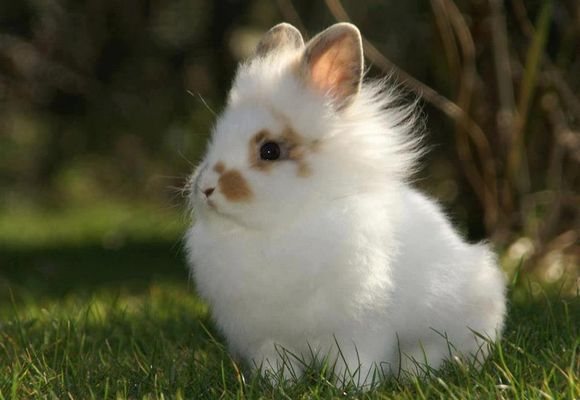

Food
The rabbit should only eat foods that are suitable for his body. Foods that people eat should not be included in his diet. He cannot be fed sweets, various meats, cookies.
Fresh grass (in season) and hay from herbs should be mandatory in the rabbit's diet.... It should be carefully checked for thorny and poisonous plants. The hay should be dry, not sticky or moldy. Drinkers should always have clean water in the cage.
When feeding fresh grass to rabbits, it must be dried - fresh or wet grass negatively affects the state of the digestive tract. Before feeding the grass to the animals, it is dried.
A proper diet should include, in addition to hay and grass, juicy roots and vegetables. They are given in small portions, gradually gradually accustoming the animals to the new food.
The rabbit should put twigs of fruit trees, linden, birch, mountain ash in the cage - the rabbits need to gnaw something, otherwise he will exercise on furniture and wooden parts of the cage.


In addition, to enhance the body's resistance, pets need to be given pharmacy vitamin complexes that contain all vitamins A, E and B necessary for the animal's body. It is best to give them in autumn or early spring.
How to determine the age of a decorative rabbit?
- Until the age of two months, it is almost impossible to do this, and there is no need if the rabbit is purchased from experienced rabbit breeders
- If there are not sufficient guarantees of the sex of the fluffy rodent, it is better to check it yourself. To do this, the animal needs to be given a reclining position, grabbing the withers with the right hand and putting it on the tail.
- With your left hand, stretch the skin in the genital area and painlessly press your thumb and forefinger along the genitals. If done correctly, primary sexual characteristics will be evident.


Determining the sex of a decorative rabbit under two months old is very difficult.
If, for some reason, the age of the acquired pet is not known, then according to certain criteria it can be approximately determined:
- the pet's ribs are soft enough for up to six months
- yellow stained teeth that lose whiteness from the age of one year of the rabbit speak of the venerable age of the animal
- long, curling nails are also a sign of aging
- swollen saggy eyelids also do not detract from the age of the rabbit


You can determine the age of a decorative rabbit by its teeth.
Care and maintenance of domestic rabbits
Domestic rabbits live in special cages. Moreover, the attribute left over from a hamster or a parrot is not suitable due to its too small size. We'll have to purchase a cage of appropriate dimensions for the "fluffy". Its height should be at least 70 centimeters, and at the bottom a deep pallet is required, where the filler will be poured.
The optimal temperature for keeping animals is 18-20 degrees, they do not tolerate drafts or direct sunlight too well - this should be taken into account when choosing where to place the rabbit in the apartment.
The animals are very clean, so be prepared to change their sawdust or hay at least 2 times a week. Ideally, if you can clean the pet's habitat once every 2 days.
Since in nature hares and rabbits live in burrows, some kind of shelters are also needed for domestic animals. It is worth placing a special "house" in the cage, where the pet will hide in case of fright or just to sleep.


You will also need a food container and a drinking bowl. Moreover, the water in it should be changed daily. Alternatively, you can use a drip (as for rodents).
The animal must be let out for walks. From time to time, allow him to run around the apartment, do not be lazy to take him out for walks. It goes without saying that before that, buy a leash and collar so that the pet does not run away. Before releasing it into the grass, treat the "fluffy" with an anti-mite agent. This is especially true for representatives of the Angora breeds. Finding bloodsucking in their thick fur will be extremely difficult.
The basis of the rabbit diet is grass or hay. It can be soaked in lightly salted water, or sprinkled with flour a little to increase its nutritional value. The digestive system of these animals works unusually quickly, so that they are fed at least 20 times a day. It is advisable to give rabbits from time to time apples, carrots, cabbage leaves, turnips, beets and young corn cobs. Vegetables are served raw or cooked.
To replenish the mineral reserve, "eared" are fed chalk, mineral stone or bone meal is introduced into their diet.
As you know, these animals love to chew on something. It is sometimes useful to put tree branches (birch, linden or apple) in their cage so that they “remove” the bark from the wood.
Caring for decorative rabbits is not particularly difficult.These are not demanding animals that easily adapt to domestic conditions. Communication with a cute "fluffy" will give a lot of positive emotions.
What and when to vaccinate decorative rabbits
Vaccination is an important part of caring for rabbits, even if they don't go outside.
If you plan to export your pet abroad, then you need to get vaccinated against rabies, although rabbits do not get sick with them.
The first time a rabbit is vaccinated when it is one and a half months old, but the weight must be at least half a kilogram, otherwise it cannot be vaccinated.


Vaccination of a decorative rabbit
In most cases, a comprehensive vaccination is done against two diseases at once. If there is none, then first you need to be vaccinated against myxomatosis, and after a week and a half - from hemorrhagic disease.
The next scheduled vaccination should be in three months, and then every six months.


Complex vaccine for decorative rabbits
How to extend the life of a pet
Preventive measures to prevent premature death of a pet and prolong its life include:
- Regular vaccination. It is imperative to vaccinate decorative rabbits against the two most dangerous diseases of a viral nature - myxomatosis and necrotizing hepatitis (viral hemorrhagic disease). If contact with other animals is possible, rabies vaccination is also advisable. The frequency of routine vaccinations is once every six months, while the first complex vaccination is done at the age of one and a half months, then revaccination is carried out after three months. The rabies vaccination calendar looks different: the first rabbit vaccination is done at the age of two to two and a half months, the subsequent ones are carried out every year.
- Complete and balanced nutrition. In addition to the usual dry food, the rabbit should always have fresh, dry and fragrant hay in the cage (it is better to buy it at the pet store, since self-dried herbs can contain pathogenic microflora and industrial waste residues that are lethal for an ornamental pet). To provide the rabbit with calcium, it is necessary to give chalk, and so that the teeth of the animal are properly grinded - solid food: sticks of fruit trees, special "spikelets" and other similar "gnawing treats".
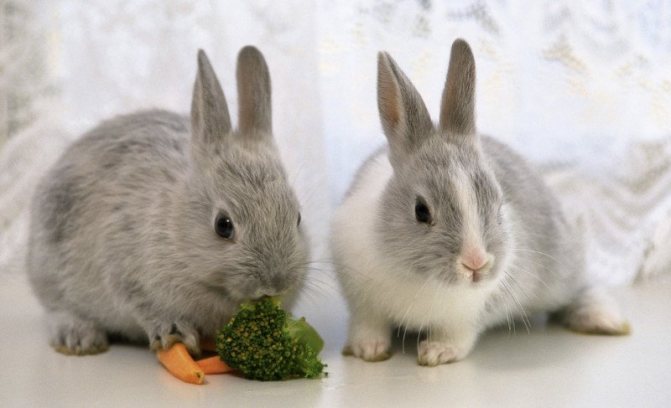

We should also not forget about vitamins: a deficiency of retinol, tocopherol, cobalamin and vitamin D is especially critical for rabbits. There are a number of seemingly safe and familiar products for rabbits that are categorically contraindicated or highly undesirable for rabbits (for example, cabbage, sunflower seeds , nuts, tomato tops, dairy, sweet, baked goods, meat, etc.). This list should be carefully studied and taken into account. - Locomotor activity. If there is an opportunity to please your pet with walks in the fresh air, it should not be neglected, but only when it comes to a country house, park, forest or meadow. In a smoky city courtyard, a pet has nothing to do, especially since such experiments are fraught with various tragic accidents - from the attack of a neighbor's dog to the death of a passing car under the wheels. However, it is imperative to release the animal from the cage every day so that the pet can “stretch the bones” and realize the need for communication at least for a couple of hours. So that the pet does not get bored the rest of the time, it is useful to place various toys, labyrinths and other entertainments in the cage, which should be changed periodically.
- Temperature conditions. To make the animal feel comfortable, the cage should not be placed in a draft, in the sun or near heating appliances. [
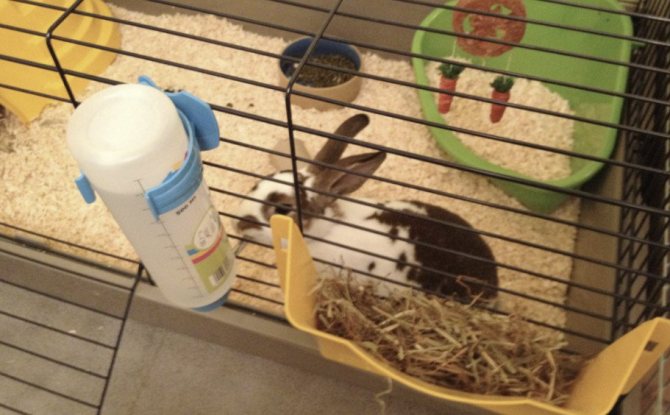

The optimum temperature, which is suitable for keeping rabbits, is in the range between 16 and 18 ° C, and the maximum permissible deviation from these parameters, both in one direction and in the other direction, is 6 ° C.Too cold air provokes colds in rabbits, and too dry and warm air affects their genitourinary system. - Minimizing bathing. Rabbit fur does not tolerate wetting well, however, in order to protect a valuable fur coat from the multiplication of various parasites, it is sometimes useful for a pet to take sand baths. Special material for these purposes can be purchased at the zoological store.
- Cleanliness in the cage. The sanitary regime is the key to the health of the fur-bearing animal. Contact with damp bedding not only adversely affects the condition of the fur and increases the development of infectious diseases, but also causes irritation of the respiratory tract due to the ingress of ammonia and carbon dioxide vapors.
- Reducing stress factors. Decorative pets do not like harsh sounds, noise and light effects, or other surprises.
- Avoiding contact with other animalsthat can scare, injure the animal, as well as infect it with any disease.
- Minimizing the risk of injury. It is household injuries that are the most common cause of the premature death of decorative rabbits. For this reason, it is better not to take animals in your arms without special need (children should be prohibited from doing this altogether), not to let them walk unattended on high planes, from where the animal can fall, carefully look at your feet when the pet is released from the cage and you can reach it step, etc. You should, in addition, know that the long ears of the rabbit are not at all designed to take the animal for them and lift it up. You can also not hold the rabbit by the paws or lower it upside down.
- Sterilization. If a pet is not used in breeding programs, it is better to spay it, since unrealized sexual instincts are the cause of the development of many serious pathologies that can lead to premature death.
- Love from the host. This rule applies to all pets, and decorative rabbits are no exception. Actually, it is the attentive and responsible attitude of the owner that allows you to find out in time that something is wrong with the animal and respond to the problem in time (adjust the conditions of keeping or diet, show the pet to the veterinarian or just play with a bored baby).
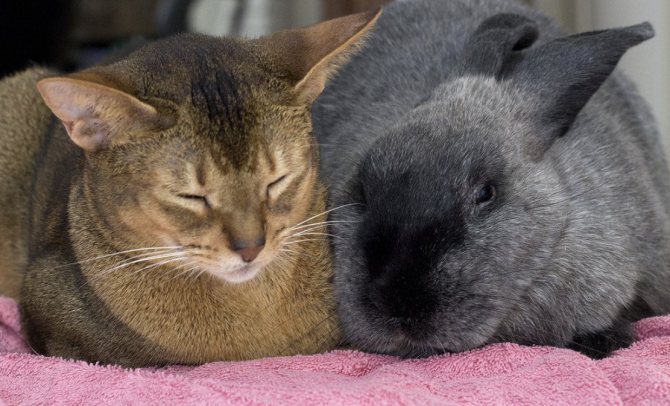

In terms of life expectancy, ornamental rabbits differ little from their wild ancestors, as well as from breeds that are bred for agricultural purposes. But if it is important for a farmer that his flock remains healthy and gains weight well only up to a certain period, the age of pets always wants to be extended as much as possible. On average, rabbits live about seven years, but if you create good conditions for your pet, it is quite possible to extend this parameter by one and a half, or even twice!
What can a decorative rabbit do and what not?
Every rabbit owner must clearly understand that improper nutrition can kill a pet.
The main food of the decorative rabbit is hay. And you can diversify the diet as follows:
- spoil sometimes with special grain mixtures, nuts, sprouted grains
- offer sprigs of cherry, apple, birch
- pieces of fruits and vegetables
- you can give a mineral stone
- it is good to please your rabbit with a dessert made from dandelion leaves
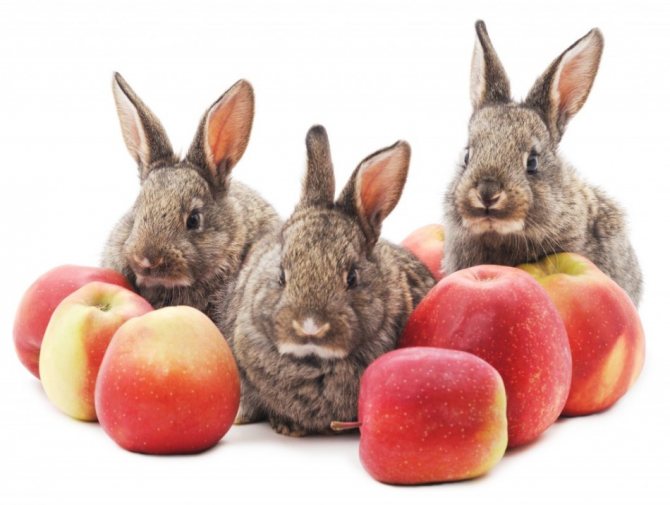

Ornamental rabbits can be offered fresh fruits and vegetables.
It is strictly forbidden:
- flour pastries and any sweets
- overseas fruits and vegetables
- any spoiled food
- grass and branches collected at the edge of the road
Why do decorative rabbits bite?
There are times when a cute furry turns into a ferocious predator and desperately tries to gnaw off the hand that feeds him. What is the reason?
- It's puberty. The problem is solved simply: get a second rabbit or hold on firmly until hormonal aggression passes
- A small personal space of a pet, which he is forced to defend from everyone, and the best way to defend himself, as we know, is an attack. It can help, if possible, buying a new cage
- Vision problems in a pet that confuses the owner's leg or arm with something dangerous for him. In such a situation, you need to be patient and show more affection, do not make sudden movements when in contact with a rabbit.
- I just don't like the smell that comes from the owner. You should try not to use perfume when communicating with your pet.
- The rabbit was taken from another family where he was mistreated. It is important to be patient and overcome mistrust together with the furry.
- The decorative rabbit bites while feeding
How long do decorative rabbits live at home?
Cute decorative rabbits are very popular not only for children, but also for many adult pet lovers. Rodents love to be played with, walk and treat them gently. It is very interesting to watch cute pets. When purchasing a decorative animal, many ask the question - how old do rabbits live? Everyone who dreams of having a fluffy pet at home wants to extend the joy of communicating with him, for which you need to know the length of his life, and what conditions of detention are necessary for him.
Decorative rabbits: reviews
Olga: I was presented with a decorative rabbit, but after a few days it began to bite strongly. Why he behaved this way, I still did not understand, so I had to get rid of him.
Tatiana: I really want to have decorative rabbits, but I'm afraid of their specific smell. I am thinking about purchasing a dwarf rabbit. I think the smell from a small animal will not be so strong.
Vasily: We bought a decorative fold-eared rabbit as a gift to our daughter 2 years ago. During this time, our Tishka has become a full member of the family and everyone's favorite. I can say with confidence that the decorative rabbit is the perfect pet.
Signs of pet aging
It is very easy to distinguish an old animal from a young one both in appearance and in behavior. But when it comes to a pet that you are in constant contact with, signs of aging can not always be noticed in time.
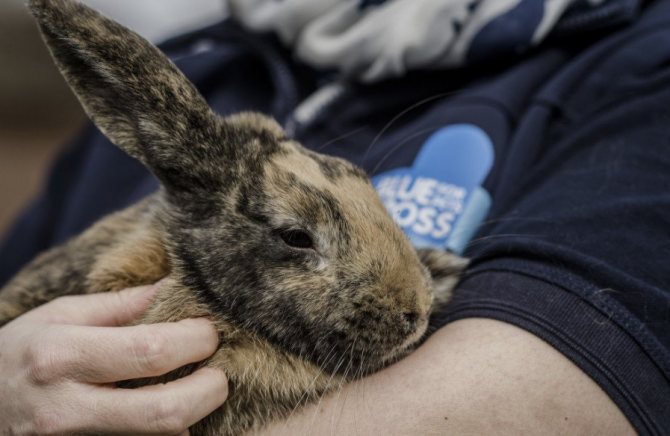

The fact that the decorative rabbit has passed from the category of a cheerful fidget to the stage of "advanced" age can be judged by the following changes:
- refusal or significant reduction in the duration of walks (the animal leaves the cage less and less willingly);
- loss of interest in favorite toys and entertainment;
- the skin does not cover the muscles, but hangs down in folds (especially on the abdomen);
- the fur becomes sparse, dull, does not hold well and falls out strongly (it seems that the animal is constantly molting), sometimes the shade of the coat changes due to a change in its structure;
- the eyes become cloudy.
Some owners note changes in the character of their aging wards (they become more capricious and less friendly), although most often the animal still shows apathy rather than aggression. Also, due to hormonal changes in the body, the animal can lose weight.
Did you know? There are legends about a certain rabbit from Nova Scotia (neither the name nor the breed of this wonderful beast is known), who allegedly lived to be twenty-four years old. However, this is most likely fiction. The official record for longevity among rabbits belongs to an Australian individual named Flopsy, who lived a little less than nineteen years. It is interesting that we are not talking about a decorative breed, but about an animal born in the wild and caught at a young age.
Signs of old age
It is not so easy for inexperienced breeders to determine the age of an animal, since from the age of three it is already quite difficult to find out about its years. From 3 to 4 months, males, as a rule, reach sexual maturity, females a little later - at 5–6 months.This is almost always accompanied by a noticeable change in behavior, and it often leads to the fact that owners abandon the pet because of aggressive behavior.
Females are very jealous of their territory, even if it is their cage. They can growl or rush at a person. Sterilization or castration in males helps to eradicate this behavior.
From 6 months to a year, the animal enters adolescence. If he has hereditary dental problems they will become apparent, so it is important to make sure that 80% or more of good hay or grass is present in the diet. At this age, rabbits may be a little moody and less socializing.
The most active phase of life is 1-3 years. The animal is very playful, tries to move more often, jumps out of the pen, creates a lot of noise in the cage. If you let the rabbit out into the open space, it will run and dig.
He becomes more and more affectionate, especially the domesticated rabbits that live near the owners. Their trust is taken to a new level, they feel completely safe in their home and can truly relax.
At the age of 5-7, age-related health problems appear, for example, arthritis, a high level of care is required. Appetite decreases, therefore, the animal's diet is completely revised. Most of the individuals at this age have chronic diseases and require the use of drugs.
Old age is reflected not only in behavior, but also in appearance:
- wool becomes sparse and its loss has nothing to do with shedding;
- the eyes no longer shine, there is no interest;
- a sagging skin is visible on the belly.
An animal in old age may begin to lose its hearing and sight. It crashes into things or seems disoriented when moving, the rabbit tries to reduce the number of movements and more often even remains free in one area. If hearing loss occurs, it may not respond to the sound of the voice. It also becomes noticeable that there is no response to stimulation, for example, when a person approaches him from behind or throws a toy in his direction.
In older individuals, additional corns on the rope, increased sensitivity to hot and cold temperatures, weight loss or gain are observed. Muscles become weak, tone is lost, and it becomes more difficult to maintain hygiene. It is difficult not to notice general health problems, including dental problems, with the bladder.
When the rabbit is young, his heels are healthy, pink, beautiful, good skin. The heel of an animal is like a human elbow - the bone is covered with skin. As it ages, constant pressure on the heel causes a build-up to appear. Thus, young individuals should have soft skin there, not calloused.
When a rabbit is about to die, its vital signs change. Some, such as shortness of breath, are visible immediately, others, such as low body temperature, are detected during examination.
In young, vibrant individuals, body temperature is usually between 38 ºC and 40 ºC, heart rate fluctuates between 180 and 250 beats per minute. Breathing - 30 to 60 breaths per minute.
Correct content
Dwarf creatures kept in normal cell conditions require regular walking.
Like other animals, they maintain their health, being constantly on the move. Keeping in a cramped cell quickly leads to metabolic disturbances. The result is obesity and the appearance of signs of various diseases. In addition, under these conditions, the work of the internal organs of the animal begins to change, and the musculoskeletal system also suffers. Paw problems are among the most common when keeping dwarf rabbits.
It is equally important to provide the rabbits with maximum comfort.It concerns not only amenities (bedding, feeders, cages, etc.), but also completely different factors. Dwarf creatures kept in normal apartment conditions must be protected from:
- bright light;
- falls from a height;
- strong noise;
- other pets (cats, dogs, rodents, etc.).
The nervous system of these animals is unstable, so you need to try to protect it as much as possible from external threats. Most often, a rabbit is a toy in the hands of a child. This should not be allowed. In such aggressive conditions for crawling, excessive fearfulness, as well as playing with children, often lead to the premature death of animals.
Those who want to have their own friend in the person of a dwarf rabbit must provide him with everything he needs. The animal quickly gets used to a person, but even over the years it does not cease to be afraid of him. It is very difficult to correct this situation. In addition, the threat from other stimuli prevents the rabbit from completely relaxing.



